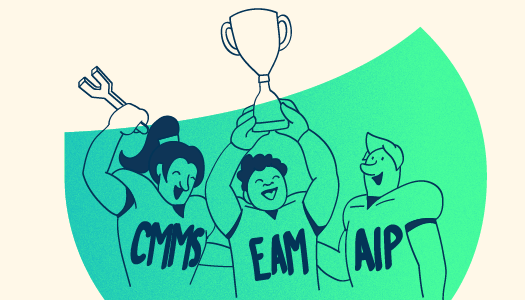Maximize Funding: How Asset Management Software Can Help Navigate the U.S. Department of Education’s Grant Programs for Spring 2024
Exciting news broke in January, as the U.S. Treasury Department announced grants exceeding $32 million for state education departments in Alabama, Arizona, California, Oregon, Pennsylvania, Rhode Island, Virginia, and the Northern Mariana Islands. These grants, part of the U.S. Department of Education’s (ED) Supporting America’s School Infrastructure (SASI) grant program, present a significant opportunity for schools to enhance their facilities. Applying for government grants and funding can be intimidating and overwhelming but having an Asset Investment Planning (AIP) software can be valuable in this process.
The SASI grant program is designed to strengthen states' capacities to assist school districts in upgrading their facilities. Most grants awarded typically range between $4.5-$5 million, with Pennsylvania receiving $2.6 million. The funding, coupled with the Renew America’s Schools Program, aims to address school infrastructure needs, implement energy improvements, and generate cost savings for districts.
The good news is for schools that are not in the awarded states, you can still apply for Renew America’s Schools Programs to receive funding. This grant is designed to provide funds for improvements in the infrastructure of K–12 public school facilities, specifically targeting high-need school communities. The initial round of applications for this Funding Opportunity Announcement (FOA) began in November 2022. The Department of Education plans to introduce a second round of opportunities for applying for the Renew America's Schools grant in the upcoming Spring of 2024.
Prioritizing Grant Applications
To make the most of this opportunity, schools should strategically prioritize their grant applications. Consider the following factors:
- Alignment with School Goals: Ensure that the proposed project aligns with the school's mission and educational objectives
- Impact and Sustainability: Evaluate the potential impact of the project and its sustainability over the long term
- Innovation: Emphasize innovative projects that contribute to a dynamic and modern learning environment
- Community Involvement: Assess the potential for community engagement and collaboration
Selecting A Project
Energy improvements are not a luxury, as aging buildings and neglected, inefficient systems compel schools to allocate funds towards utilities instead of classrooms, impacting student learning. Recently, many districts experienced repeated missed school days due to extreme heat in August, a trend expected to worsen with climate-induced warming trends in regions lacking standard air conditioning—including my own state of Connecticut!
- 95% of the nation's 476,000 school buses use diesel fuel, posing respiratory health risks
- 53% of school districts in 2019 expressed the need to replace multiple building systems
- 41% of districts reported that over half of their schools require HVAC upgrades
- 40% of schools lack a facilities plan for long-term maintenance and upgrades
- 31% of school systems utilize portable facilities, with 45% of them in poor or fair condition
- 16% of districts have not assessed their building needs in over 10 years
Leveraging AIP Software for Informed Decision
AIP software, like Brightly’s solution, can significantly enhance the decision-making process. By inputting various criteria into the software, schools can benefit from:
- Data-Driven Insights: AIP processes vast amounts of data to provide data-driven insights, ensuring well-informed decisions
- Predictive Analytics: AIP predicts the potential success of a grant by analyzing historical data and patterns
- Resource Optimization: AIP helps schools optimize fund allocation for maximum impact
Applying for the Grant
Once priorities are set, schools can proceed with the application process. Follow the guidelines outlined by the U.S. Department of Education, emphasizing how the proposed project aligns with the goals of the SASI grant. Renew America’s Schools also offers suggestions for partnerships to help schools move forward with projects.
Additional Funding Opportunities
Beyond grant applications, schools can explore clean energy tax credits for qualifying projects. These credits include the investment tax credit, production tax credit, and others. Projects supported by tax credits include energy infrastructure improvements, solar panels, microgrids, and clean energy vehicles.
The DOE, alongside the Renew America’s Schools grant, also introduced the Energy Champions Leading the Advancement of Sustainable Schools Prize (Energy CLASS Prize), a $4.5 million prize program. The competitive award, spanning two phases, is designed to aid high-need K–12 schools by establishing, training, and supporting energy managers. As of May 5, 2023, 25 winners were announced, each receiving $100,000 and access to the Energy CLASS Prize Training Network.
The Supporting America’s School Infrastructure grant presents a transformative opportunity for schools to enhance their facilities. By strategically prioritizing applications and utilizing AIP software, schools can make more informed decisions to maximize their chance of receiving funding and improve the overall impact that funding can have on their learning environments.
For schools applying to these grant programs, or other future facilities funding opportunities arise, having a solid foundation and AIP software in place can make it much easier to determine exactly what projects you should prioritize and help get the most out of your application by providing data-driven insights to support your decisions. Be ready for any grant that becomes available with your AIP software data to quickly apply and select your priorities for application!



